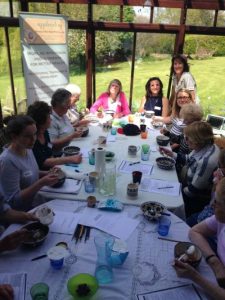A new client who was seeing me for hormone support told me yesterday that she wished she’d come to my autoimmune workshop the previous week. I asked her if she had a relative or friend suffering from an autoimmune disease. ‘No, but I seem to get one cold after another.’ Then she saw the puzzled look on my face and added, ‘What IS an auto immune disease exactly?’

At last week’s workshop I realized there’s quite a bit of confusion when it comes to the term Autoimmunity.
People hear ‘immune’ and think it’s to do with winter colds and coughs and being run down.
Another perplexing aspect may be that there are now so many diseases being considered autoimmune in their aetiology. From psoriasis to ulcerative colitis, Crohns, Hashimotos and another 100 + diseases. And this number is on the rise as research uncovers possible autoimmune components to some known and familiar conditions.
Add to this the fact that some doctors don’t actually tell their patients that their disease is autoimmune in nature. From a conventional medical perspective their treatment is the same, however, from a functional medicine point of view it makes a big difference.
Here’s some information on different aspects of autoimmunity which I’ve based on my own clinic experience, and IFM (Institute of Functional Medicine) teachings, as well as CAM – now IHCAN – conferences, seminars by Lamberts and NutriLink and various webinars. There’s a wealth of literature out there on autoimmunity, from a functional medicine perspective, just google Dr Ballantyne’s AI Paleo approach, or Dr Kharrazian’s and Tom O’Bryan’s books, to mention just a few.
For a start, a smidgeon of basic science 🙂 Normally the immune system attacks a foreign body, such as bacteria, parasites or a virus (called ‘pathogens’) which tends to give you symptoms, make you feel unwell to varying degrees. This takes place thanks to our antibodies, a type of protein whose job it is to recognize patterns in other proteins, find the ones that are foreign, like the aforementioned bacteria, viruses, fungi, and then bind and ‘deactivate’ them.
By binding to these foreign proteins the antibody is signalling to the immune system, ‘this is an invader, come and get it.’
A truly brilliant internal army of antibodies, proteins, chemicals a.o., all working together to then eliminate anything that shouldn’t be in our system.
With an autoimmune disease, however, the body accidentally creates antibodies that target our bodies’ proteins, instead of the foreign invading pathogens’ proteins. This happens because some of the amino acid (protein) sequences of a body organ or tissue can look very similar to the sequencing of that pathogen invader!
This mistaken identity is called molecular mimicry or cross reactivity. Dr Sarah Ballantyne quite accurately calls it a “betrayal of our immune system”. Instead of attacking foreign organisms, our immune system mistakenly attacks itself, hence the word ‘auto,’ which is Greek for ‘self.’
Diagnosing an autoimmune condition can be tricky. Treatment may not be helping (because the root problem is still not addressed). Symptoms may be vague or sporadic, ticking over for years and not doing anything dramatic, just making you feel very unwell at times, or all the time, with no clear ‘name’ of what the illness might be. Very frustrating for you, the patient, as well as your doctor.
On top of that, there isn’t a specialist for autoimmune disease in general. Conventional medical treatment is organ, or system, dependent.
Hence if you google ‘doctors for autoimmune conditions’ you’ll find a very long list, from nephrologist, a specialist treating kidney problems, hence also auto immune [AI] diseases affecting the kidney such as lupus; or a rheumatologist, for arthritis, but also AI rheumatic diseases, such as scleroderma; an endocrinologist, treating gland and/or hormone problems, hence also AI diseases like Hashimotos or Graves thyroid disease; a neurologist for nerve problems and hence also AI diseases such as multiple sclerosis; a gastroenterologist, for digestive system disorders, and thus also the AI disease Crohns or ulcerative colitis; a dermatologist for skin issues and also AI diseases such as urticaria and psoriasis. And so it goes on.
Autoimmune diseases have a tendency to gather in numbers over time. If you start off with one you may then acquire another and another, and end up having to juggle multiple specialist appointments and multiple medications… with multiple side effects.
Once diagnosed with an autoimmune disease you have it for life. There’s no cure – yet. However management of symptoms can make it feel like you don’t have the disease, which is a real positive.
Typical medical treatments may include immunosuppressive medication or stronger drugs like anti rheumatics, plus pain medication. These calm down the immune response, but won’t be solving the underlying problem (hence no cure. Yet).
Currently, a lot of research is being carried out regarding AI diseases as they are on the rise; worryingly so. They are, in fact, the 3rd leading cause of mortality in the industrialised world after cancer and heart disease. Plus, as mentioned above, there are over 100 already confirmed AI diseases, with more being implicated in having their roots in autoimmunity (ie. more diseases where research is showing the body attacking ‘self’).
From a functional medicine point of view, what is understood through research and practice, is that a triad of factors is normally present in order to develop an auto immune disease. Genetics. Environmental triggers. Diet/lifestyle.
Genes alone are not enough, so don’t panic if autoimmune conditions run in the family. Having these genetic links will, however, make you more vulnerable to an AI condition than someone without this genetic component.
Environmental triggers, the second factor, cover such a vast potential range that I can only touch on them with a light stroke that doesn’t do justice to their impact.
Infections, past and present, such as viruses, bacterial overgrowths in the gut, infections in the lungs and sinuses to point out just a few. Inhaled or ingested toxins (think of all the chemicals surrounding us, from cleaning products, cosmetics, pesticides, food additives, plastics…). Hormones, where our chemical messengers trigger changes in the body. Stress or trauma, grief, unhealthy relationships…and the list goes on.
Often there is more than one ‘trigger’ involved; a synergy of different factors coming together at a certain point in your life, rather than blame being laid on just one.
That being said, coeliac disease, a well-known autoimmune condition, has its roots in just one trigger/mediator, namely gluten. This is a protein found in many grains. This is the reason why grains and pseudo grains are considered by many practitioners in the functional medicine world to be triggers or mediators in ALL auto immune diseases (do read Tom O’Bryan’s books on gluten, or watch on Youtube).
Unlike genetics, you can take control to varying degrees, of the environmental triggers in your life.
Diet and lifestyle, the third factor in this triad, have such an impact on your health, on your immune system, that it can’t be emphasised enough. It may may sound like a cliche that slides too easily off the tongue, but You Are indeed What You Eat.
The gut wall, your digestive lining, is a vital barrier between your inside and outside world.
You ingest food via your mouth, and it remains enclosed within the tube of your digestive tract – which is still ‘outside’ the bloodstream and the rest of your body – until it is absorbed through the gut wall. There it enters your ‘inside’ world. Nutrients are then transported all over your body, carried in your blood to the rest of your organs and body tissue.
This gut wall has to be selectively permeable in order to allow nutrients in, but at the same time keep out toxins, those pathogens mentioned above.
Little wonder about 80% of the immune system is here, in these tissues of the gut. An army of antibodies, proteins and chemicals a.o. are all on guard to ensure that whatever passes through that gut wall ‘barrier’ isn’t foreign and make you ill.
Loss of this protection seems to be a critical factor in autoimmune disease. Either the cells in the gut wall can become damaged, or the junctions between these cells can lose their closely formed tight integrity, thus allowing some contents of the gut to ‘leak’ into the bloodstream or lymphatic system – hence the term ‘leaky gut’. This may then result in the whole immune system going into overdrive if you consider that undigested food, with unrecognisable sequencing, is entering the body when it shouldn’t and is being mistaken for pathogens. (This is a very brief and simple mini tour of what can go wrong!)
Currently it’s thought that leaky gut or intestinal permeability is implicated in most auto immune disease Saying that, I have seen AI clients whose lab tests showed no intestinal permeability. Interestingly, however, they had sinus and lung issues. There is research looking at how the epithelial linings/barriers of other hollow spaces, such as lungs, sinuses, urinary tract, may be the compromised barriers in the body which are setting up this autoimmune landscape.
How to improve intestinal permeability? The good news is that the gut wall cells turn over and heal very quickly, but infections and a potentially imbalanced microbiome should be investigated. At the same time, dietary changes need to be made according to the individual. There are certain foods that are never going to be great. Processed and pre-packaged meals or high sugar/low nutrient diets. Alcohol and coffee can be problematic for many. Gluten and possibly other grains. Dairy. Some people struggle with digesting certain proteins – meat or pulses. And of course, there may be foods, some even so-called healthy foods, to which you have an allergy or intolerance. Often people will only have to stay off ‘their’ problem foods for a relatively short time, some months. However, others feel so much better when they exclude certain foods they keep off them. It’s very individual, which is why it helps to work with someone, a qualified nutritionist or functional medicine practitioner.
As for lifestyle, the benefit of regular and manageable exercise is now so well understood regarding all disease, I won’t harp on it.
Stress, as always, plays a key role. It can be both a trigger as well as an insidious mediator, propelling your auto immune disease ever forward. We all have stress in our lives; we all have to ensure we can tone it down and find the ‘off; switch.
Sleep is vital. If you’re not getting good sleep this will scupper your immune health. There are so many ways to improve sleep, and tests to investigate why your sleep is disturbed so do contact me if you want to discuss this.
Mindfulness, supportive relationships at home or in the community and having purpose in life. All of these are significant lifestyle factors. Consider each one with care – mindfully. This will be key in helping you manage your autoimmune disease and improve symptoms.
And if all the above is too much to get your head around, find someone to work with, a functional therapist or nutritionist who can help you organise lab tests and discuss diet and look at the different layers to your health.
Making a start with Intention is a great first step. Keeping a food diary to see if you can tease out patterns to your symptoms. Gradually increasing a manageable amount of daily exercise. Taking a close look at the stress in your life, at the love in your life. Surrounding yourself with angels who are supportive.
There’s a lot you can do and think about right now!









